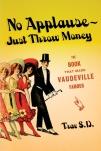In 1926, live vaudeville was slammed with a new type of competition in the form of variety on the silver screen. Warner Brothers came out with Vitaphone that year, a means of syncing up sound recording with films. The name came from Vitagraph, the silent movie studio the Warners had recently acquired. Experimental talking shorts (almost all starring top vaudevillians) followed. These little films were almost precisely analogous to a vaudeville act in length and format. Very often done in one single long shot with no edits (much like the earliest silent films), the film would simply depict the performer doing their act, as though it were for a live audience. Many or most of these were produced and directed by Bryan Foy, himself a vaudeville veteran.
This innovation was a double edged sword. On the one hand, it was deadly competition for live vaudeville. Edward Albee declared Vitaphone to be on the “opposition list”, i.e. off limits to big time vaudeville acts, just as he had done earlier with radio. But the acts chose Vitaphone (or its competitor Fox Movietone) just the same.
On the other hand, films did vaudeville a service even as they were killing it: by preserving it. In addition to the original flood of Vitaphone shorts in the late 20s and early 30s, Warner Brothers did a series called Vitaphone Vaudeville from 1934-36 that captured small bills of 4-5 acts for distribution to cinemas.
While Vitaphone was the most prolific and highly visible of such series, it was not the first. Prior to Warner Brothers’ sound-on-disc system, Lee De Forest, inventor of the vacuum tube, had introduced an alternate sound-on-film system called DeForest Phonofilm. From 1922 through 1929 De Forest made around 300 demonstration films with this process, which didn’t receive Warner Brothers’ wide distribution. Though it was little known to the public at the time, historians and fans cherish the surviving examples now, as the oldest of them are four years older than even the oldest Vitaphone. And, still more thrillingly, in 1913 Edison demonstrate his Kinetophone, which we wrote about here. These are exciting times.
Later developments included Fox Movietone and RCA Photophone (which RKO used), both refinements and improvements about the DeForest system. While they did record some vaudeville acts, neither captured as many vaudeville acts as Vitaphone. (Fox Movietone, for example, remains best known for their newsreels). But the bottom line is, with all these various series, the studios (probably without meaning to) made it possible for us to sit down today and look at a record of many of the major and some of the minor acts of late vaudeville.
Since, 1991 The Vitaphone Project has made a Herculean effort to find and restore the old Vitaphones. Many of their efforts are now available as Warner Brothers re-releases on DVD, can be seen on Youtube. For years, the Vitaphone Project’s Ron Hutchinson presented regular screenings at the Film Forum. For more on the Vitaphone Project go here.
In, 2011, my American Vaudeville Theatre and Travalanche, in collaboration with Vaudevisuals.com launched Vaudephone, our latter-day tribute to the original Vitaphone and MovieTone vaudeville series, revitalized for the Youtube Age. Please check it out here!
To find out more about the history of vaudeville, consult No Applause, Just Throw Money: The Book That Made Vaudeville Famous, available at Amazon, Barnes and Noble, and wherever nutty books are sold.


![vitaphone3[1]](https://travsd.files.wordpress.com/2011/10/vitaphone31.jpg?w=723)